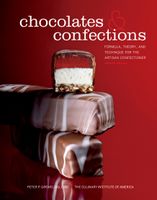Advertisement
Technique Theory: Starch Molding
Appears in
By Peter Greweling and Culinary Institute of America
Published 2007
The steps in starch molding are simple: Make an impression of a desired shape in a shallow bed of dry starch. Deposit the desired soft medium into the impression and allow it to set. When the set confection is removed from the starch, it will have the shape of the impression originally made in the starch bed. The confection may be finished as desired.
- Aerate Well-Dried Cornstarch in Shallow Boxes by Whisking or Sifting. Level the starch flush with the top of the box. The box for starch molding should be shallow in order to contain the minimum amount of starch. The box should be a size that fits on convenient storage trays, often sheet pans. The starch can be simply cornstarch, although some confectioners prefer a mixture of different starches. In larger operations, starch marketed specifically for molding is treated with a small quantity of mineral oil to prevent it from absorbing liquid confections. In all cases, it is crucial that the starch be well dried. To do this, dry it in the box in a low-temperature oven (93°C/200°F or lower) for several hours. If the starch is not sufficiently dried, it will attract rather than repel the liquid deposited in it, absorbing it. If the starch box has been stored under ambient conditions for several days, it may be necessary to dry it before molding. Once dried, the starch is ready for use. Aerate the starch by lightly whisking with a whip, then level off the surface so it is flush with the edges of the box. The aerated and leveled bed of starch can now be imprinted and filled as desired.
- Make Cavities in the Starch Bed Using an Imprinter. Imprinters are easy tools to make. Making original imprinters allows the confectioner to create unique shapes for products. The simplest way to make an imprinter is to buy an inexpensive chocolate mold of the size and shape desired, spray it with a pan release, and then fill it with plaster of Paris. When the shaped plaster hardens, release it from the chocolate mold and allow it to cure overnight. Once the plaster forms are fully cured, glue them onto a wooden stick leaving 1 centimeter/½ inch or more between each form. Imprinters may also be made by sculpting clay that is subsequently cured in an oven, or even by using existing objects, such as toys, and attaching them to a stick.
- Funnel the Liquid Center into the Prepared Starch Cavities. Use a fondant funnel to deposit the fluid mixture into the prepared molds. In many cases it is important to keep the funnel warm during depositing.
- If Desired, Sift Dry Starch on Top of the Still-Liquid Centers. In the case of liquor cordials, starch should be sifted over the top of the centers to promote crystallization. When molding jellies in starch, this step may be omitted.
- Allow the Filling to Set or Crystallize for the Required Time in the Box. The length of time the filling should be left in the starch varies with the product. Pectin jellies should be removed as soon as they have set; gelatin gummies should be left in the starch overnight. Liquor cordials must also remain in the starch overnight, but they should be turned over after 4 to 5 hours to allow an even skin of crystallization to form. Brush candies free of excess starch.



